Characterization of a Modified Clinical Linear Accelerator for Ultra-High Dose Rate Beam Delivery
Abstract
1. Introduction
2. Materials and Methods
- (i)
- At the isocenter position (SSD = 100 cm);
- (ii)
- At the isocenter position with a PMMA cylindrical applicator with a 5 cm inner diameter;
- (iii)
- At the crosshair foil (SSD = 52.9 cm) at the exit of the LINAC head;
- (iv)
- In the wedge tray (SSD = 18.6 cm) inside the LINAC head.
2.1. Clinical Accelerator Upgrade
2.2. Pulse Characterization with Silicon Sensors
2.3. Dosimetry Measurements
3. Results
3.1. Beam Pulse Characterization
3.2. Dosimetry
4. Discussion
5. Conclusions
Author Contributions
Funding
Institutional Review Board Statement
Informed Consent Statement
Data Availability Statement
Acknowledgments
Conflicts of Interest
References
- Favaudon, V.; Caplier, L.; Monceau, V.; Pouzoulet, F.; Sayarath, M.; Fouillade, C.; Poupon, M.-F.; Brito, I.; Hupé, P.; Bourhis, J.; et al. Ultrahigh dose-rate FLASH irradiation increases the differential response between normal and tumor tissue in mice. Sci. Transl. Med. 2014, 6, 245ra93. [Google Scholar] [CrossRef] [PubMed]
- Montay-Gruel, P.; Petersson, K.; Jaccard, M.; Boivin, G.; Germond, J.F.; Petit, B.; Doenlen, R.; Favaudon, V.; Bochud, F.; Bailat, C.; et al. Irradiation in a Flash: Unique Sparing of Memory in Mice after Whole Brain Irradiation with Dose Rates above 100 Gy/s. Radiother. Oncol. 2017, 124, 365–369. [Google Scholar] [CrossRef] [PubMed]
- Vozenin, M.C.; De Fornel, P.; Petersson, K.; Favaudon, V.; Jaccard, M.; Germond, J.F.; Petit, B.; Burki, M.; Ferrand, G.; Patin, D.; et al. The Advantage of FLASH Radiotherapy Confirmed in Mini-pig and Cat-cancer Patients. Clin. Cancer Res. 2019, 25, 35–42. [Google Scholar] [CrossRef] [PubMed]
- Hageman, E.; Che, P.-P.; Dahele, M.; Slotman, B.J.; Sminia, P. Radiobiological Aspects of FLASH Radiotherapy. Biomolecules 2022, 12, 1376. [Google Scholar] [CrossRef]
- Di Martino, F.; Barca, P.; Barone, S.; Bortoli, E.; Borgheresi, R.; De Stefano, S.; Di Francesco, M.; Faillace, L.; Giuliano, L.; Grasso, L.; et al. FLASH Radiotherapy With Electrons: Issues Related to the Production, Monitoring, and Dosimetric Characterization of the Beam. Front. Phys. 2020, 8, 570697. [Google Scholar] [CrossRef]
- Romano, F.; Bailat, C.; Jorge, P.G.; Lerch ML, F.; Darafsheh, A. Ultra high dose rate dosimetry: Challenges and opportunities for FLASH radiation therapy. Med. Phys. 2022, 49, 4912–4932. [Google Scholar] [CrossRef]
- Vignati, A.; Giordanengo, S.; Fausti, F.; Martì Villarreal, O.A.; Mas Milian, F.; Mazza, G.; Shakarami, Z.; Cirio, R.; Monaco, V.; Sacchi, R. Beam Monitors for Tomorrow: The Challenges of Electron and Photon FLASH RT. Front. Phys. 2020, 8, 375. [Google Scholar] [CrossRef]
- Giannini, N.; Gadducci, G.; Fuentes, T.; Gonnelli, A.; Di Martino, F.; Puccini, P.; Naso, M.; Pasqualetti, F.; Capaccioli, S.; Paiar, F. Electron FLASH Radiotherapy in Vivo Studies. A Systematic Review. Front. Oncol. 2024, 14, 1373453. [Google Scholar] [CrossRef]
- Rahman, M.; Trigilio, A.; Franciosini, G.; Moeckli, R.; Zhang, R.; Böhlen, T.T. FLASH Radiotherapy Treatment Planning and Models for Electron Beams. Radiother. Oncol. 2022, 175, 210–221. [Google Scholar] [CrossRef]
- Lempart, M.; Blad, B.; Adrian, G.; Bäck, S.; Knöös, T.; Ceberg, C.; Petersson, K. Modifying a Clinical Linear Accelerator for Delivery of Ultra-High Dose Rate Irradiation. Radiother. Oncol. 2019, 139, 40–45. [Google Scholar] [CrossRef]
- Snyder, M.; Vadas, J.; Musselwhite, J.; Halford, R.; Wilson, G.; Stevens, C.; Yan, D. FLASH radiotherapy monitor chamber signal conditioning. Med. Phys. 2021, 48, 791–795. [Google Scholar] [CrossRef] [PubMed]
- Dal Bello, R.; Von Der Grün, J.; Fabiano, S.; Rudolf, T.; Saltybaeva, N.; Stark, L.S.; Ahmed, M.; Bathula, M.; Kucuker Dogan, S.; McNeur, J.; et al. Enabling Ultra-High Dose Rate Electron Beams at a Clinical Linear Accelerator for Isocentric Treatments. Radiother. Oncol. 2023, 187, 109822. [Google Scholar] [CrossRef]
- Cetnar, A.J.; Jain, S.; Gupta, N.; Chakravarti, A. Technical note: Commissioning of a linear accelerator producing ultra-high dose rate electrons. Med. Phys. 2024, 51, 1415–1420. [Google Scholar] [CrossRef] [PubMed]
- Schüler, E.; Trovati, S.; King, G.; Lartey, F.; Rafat, M.; Villegas, M.; Praxel, A.J.; Loo, B.W.; Maxim, P.G. Experimental Platform for Ultra-High Dose Rate FLASH Irradiation of Small Animals Using a Clinical Linear Accelerator. Int. J. Radiat. Oncol. Biol. Phys. 2017, 97, 195–203. [Google Scholar] [CrossRef] [PubMed]
- Yan, W.; Khan, M.K.; Wu, X.; Simone CB 2nd Fan, J.; Gressen, E.; Zhang, X.; Limoli, C.L.; Bahig, H.; Tubin, S.; Mourad, W.F. Spatially fractionated radiation therapy: History, present and the future. Clin. Transl. Radiat. Oncol. 2019, 20, 30–38. [Google Scholar] [CrossRef] [PubMed] [PubMed Central]
- Pensavalle, J.H.; Romano, F.; Celentano, M.; Sarto, D.D.; Felici, G.; Franciosini, G.; Masturzo, L.; Milluzzo, G.; Patera, V.; Prezado, Y.; et al. Realization and dosimetric characterization of a mini-beam/flash electron beam. Front. Phys. 2023, 11, 1269495. [Google Scholar] [CrossRef]
- Medina, E.; Ferro, A.; Abujami, M.; Camperi, A.; Centis Vignali, M.; Data, E.; Del Sarto, D.; Deut, U.; Di Martino, F.; Fadavi Mazinani, M.; et al. First experimental validation of silicon-based sensors for monitoring ultra-high dose rate electron beams. Front. Phys. 2024, 12, 1258832. [Google Scholar] [CrossRef]
- International Atomic Energy Agency. Absorbed Dose Determination in External Beam Radiotherapy; Technical Reports Series; Rev. 1; International Atomic Energy Agency: Vienna, Austria, 2024; ISBN 978-92-0-146022-6. [Google Scholar]
- Subiel, A.; Moskvin, V.; Welsh, G.H.; Cipiccia, S.; Reboredo, D.; DesRosiers, C.; Jaroszynski, D.A. Challenges of Dosimetry of Ultra-Short Pulsed Very High Energy Electron Beams. Phys. Medica 2017, 42, 327–331. [Google Scholar] [CrossRef]
- McManus, M.; Romano, F.; Lee, N.D.; Farabolini, W.; Gilardi, A.; Royle, G.; Palmans, H.; Subiel, A. The challenge of ionisation chamber dosimetry in ultra-short pulsed high dose-rate Very High Energy Electron beams. Sci. Rep. 2020, 10, 9089. [Google Scholar] [CrossRef]
- Niroomand-Rad, A.; Blackwell, C.R.; Coursey, B.M.; Gall, K.P.; Galvin, J.M.; McLaughlin, W.L.; Meigooni, A.S.; Nath, R.; Rodgers, J.E.; Soares, C.G. Radiochromic film dosimetry: Recommendations of AAPM Radiation Therapy Committee Task Group 55. Med. Phys. 1998, 25, 2093–2115. [Google Scholar] [CrossRef]
- Devic, S.; Seuntjens, J.; Sham, E.; Podgorsak, E.B.; Schmidtlein, C.R.; Kirov, A.S.; Soares, C.G. Precise radiochromic film dosimetry using a flat-bed document scanner. Med. Phys. 2005, 32, 2245–2253. [Google Scholar] [CrossRef]
- Costa, F.; Sarmento, S.; Sousa, O. Assessment of clinically relevant dose distributions in pelvic IOERT using Gafchromic EBT3 films. Phys. Medica 2015, 31, 692–701. [Google Scholar] [CrossRef] [PubMed][Green Version]
- Strydom, W.; Parker, W.; Olivares, M. Chapter 8 electron beams: Physicaland clinical aspects. In Radiation Oncology Physics: A Handbook for Teachers and Students; McGill University: Montreal, QC, Canada; IAEA: Vienna, Austria, 2006; pp. 1–46. [Google Scholar]
- Ashraf, M.R.; Rahman, M.; Zhang, R.; Williams, B.B.; Gladstone, D.J.; Pogue, B.W.; Bruza, P. Dosimetry for FLASH Radiotherapy: A Review of Tools and the Role of Radioluminescence and Cherenkov Emission. Front. Phys. 2020, 8, 328. [Google Scholar] [CrossRef]
- Konradsson, E.; Wahlqvist, P.; Thoft, A.; Blad, B.; Bäck, S.; Ceberg, C.; Petersson, K. Beam control system and output fine-tuning for safe and precise delivery of FLASH radiotherapy at a clinical linear accelerator. Front. Oncol. 2024, 14, 1342488. [Google Scholar] [CrossRef] [PubMed]
- Faillace, L.; Alesini, D.; Bisogni, G.; Bosco, F.; Carillo, M.; Cirrone, P.; Cuttone, G.; De Arcangelis, D.; De Gregorio, A.; Di Martino, F.; et al. Perspectives in linear accelerator for FLASH VHEE: Study of a compact C-band system. Phys. Medica 2022, 104, 149–159. [Google Scholar] [CrossRef]

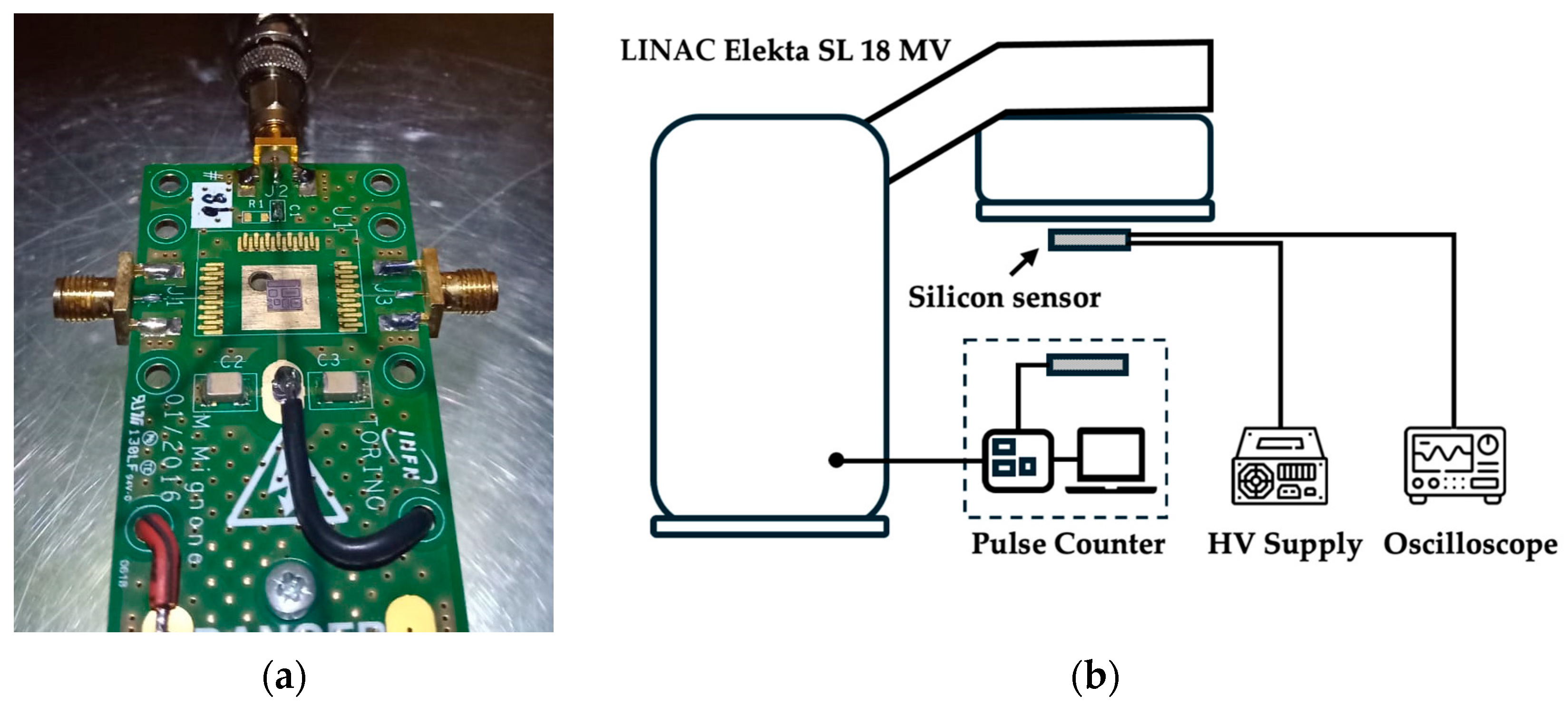
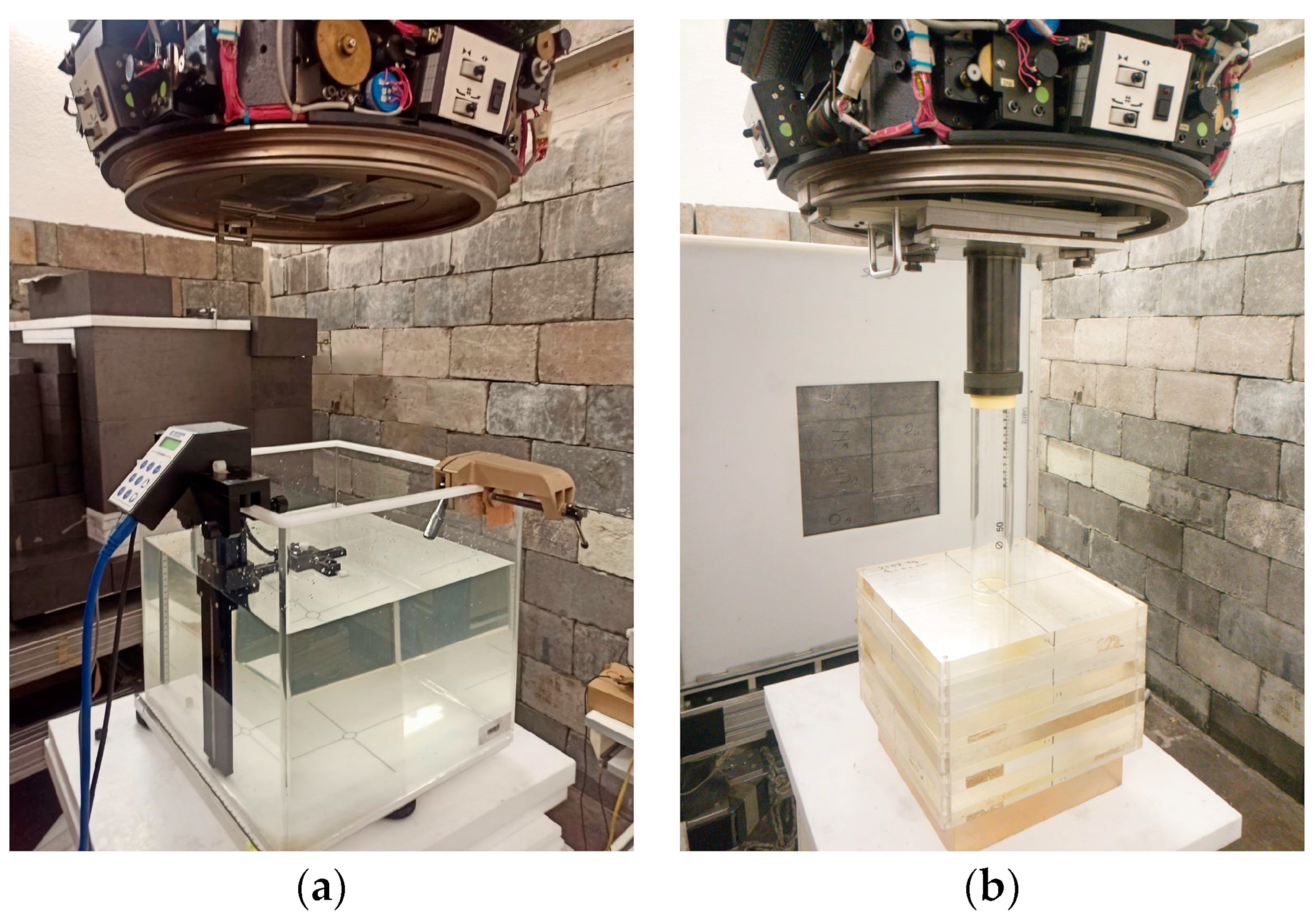
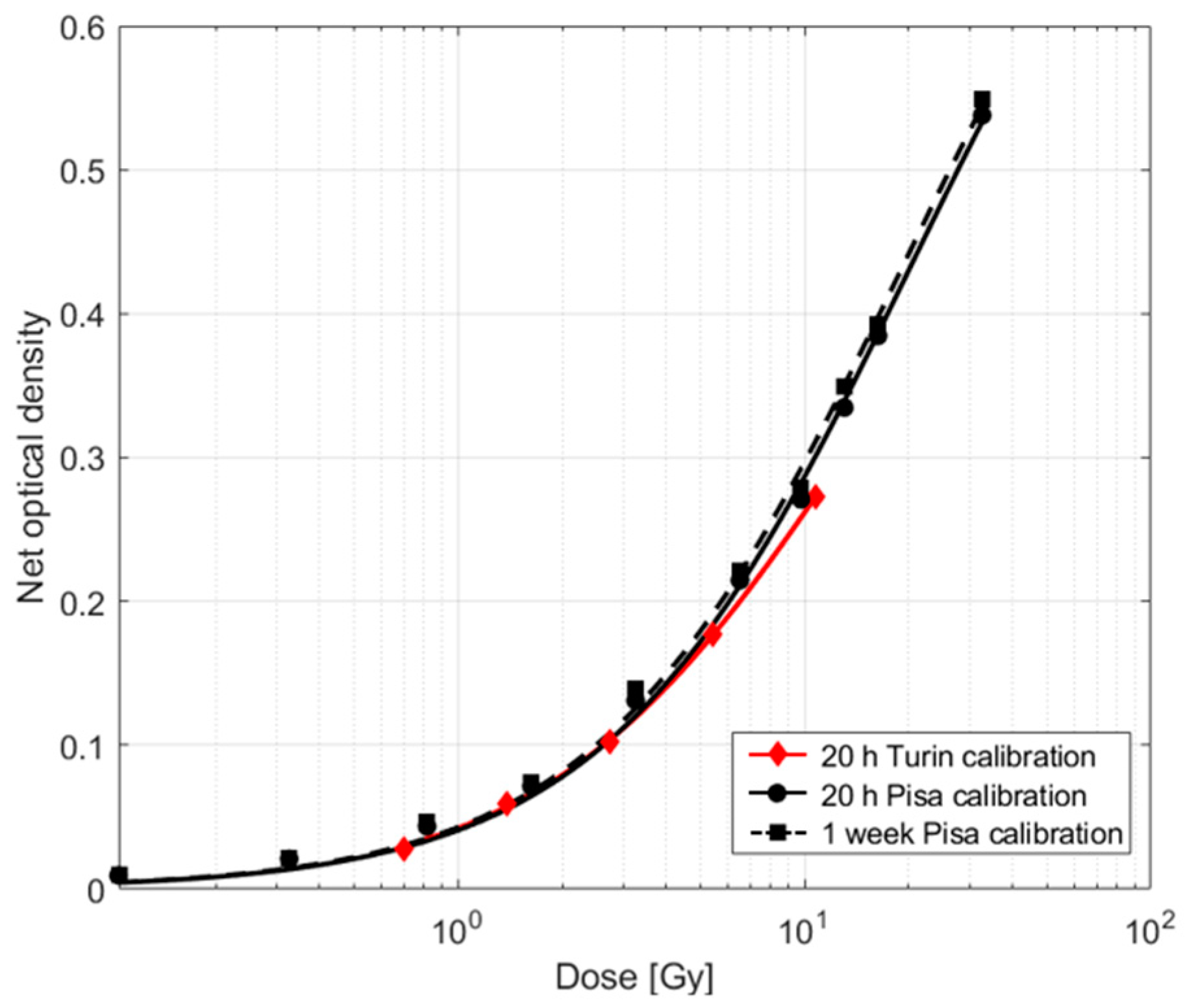
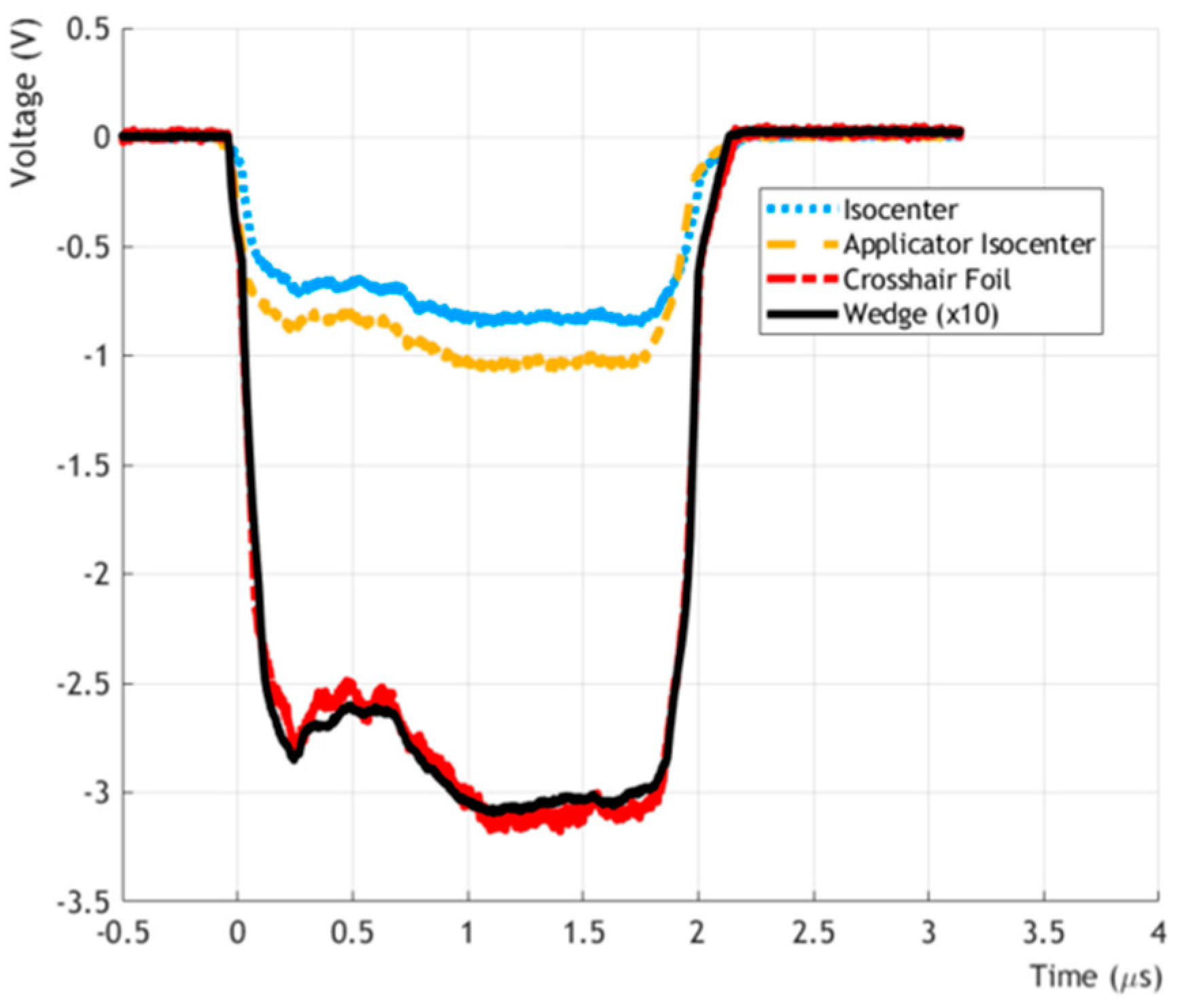
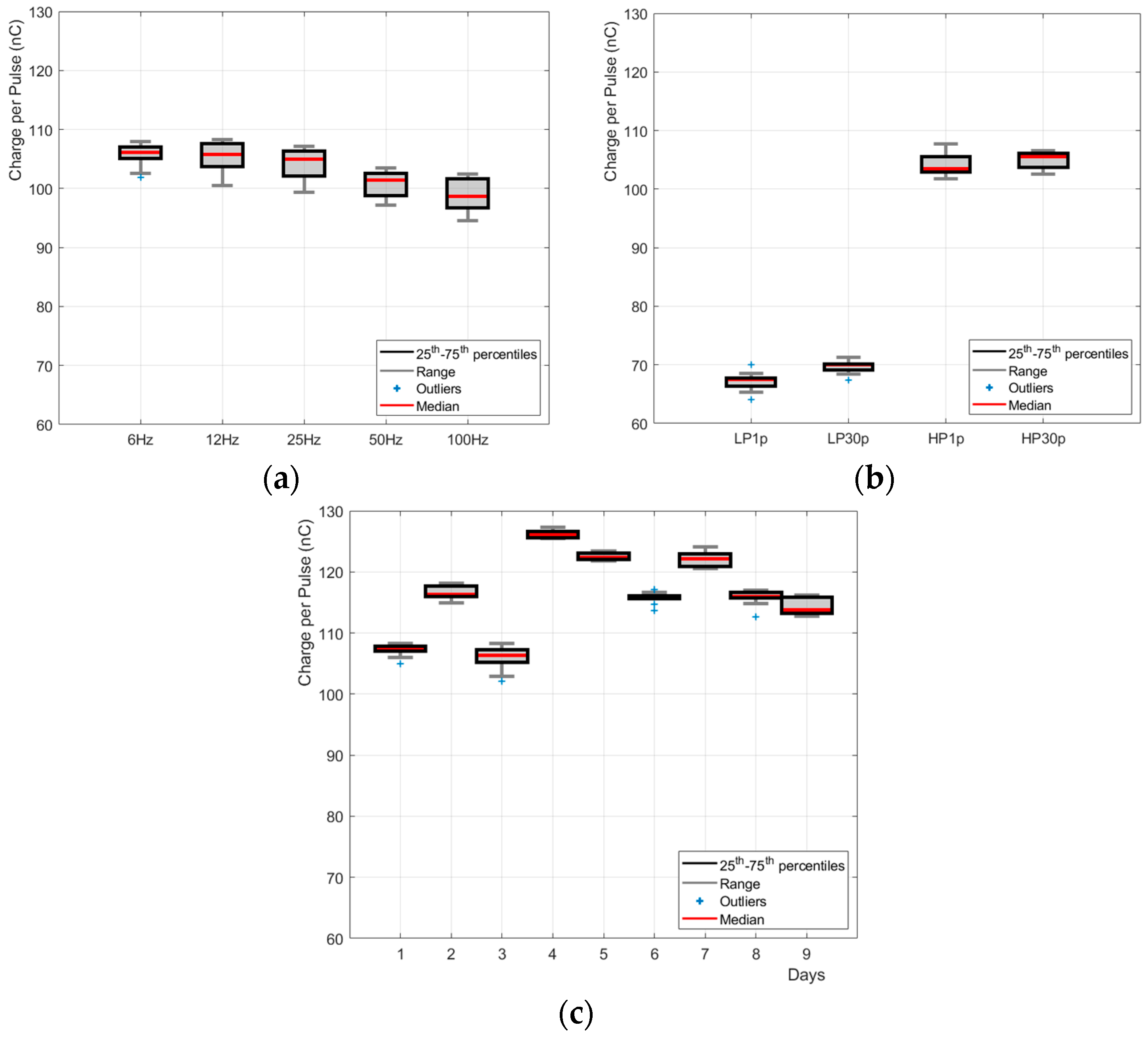


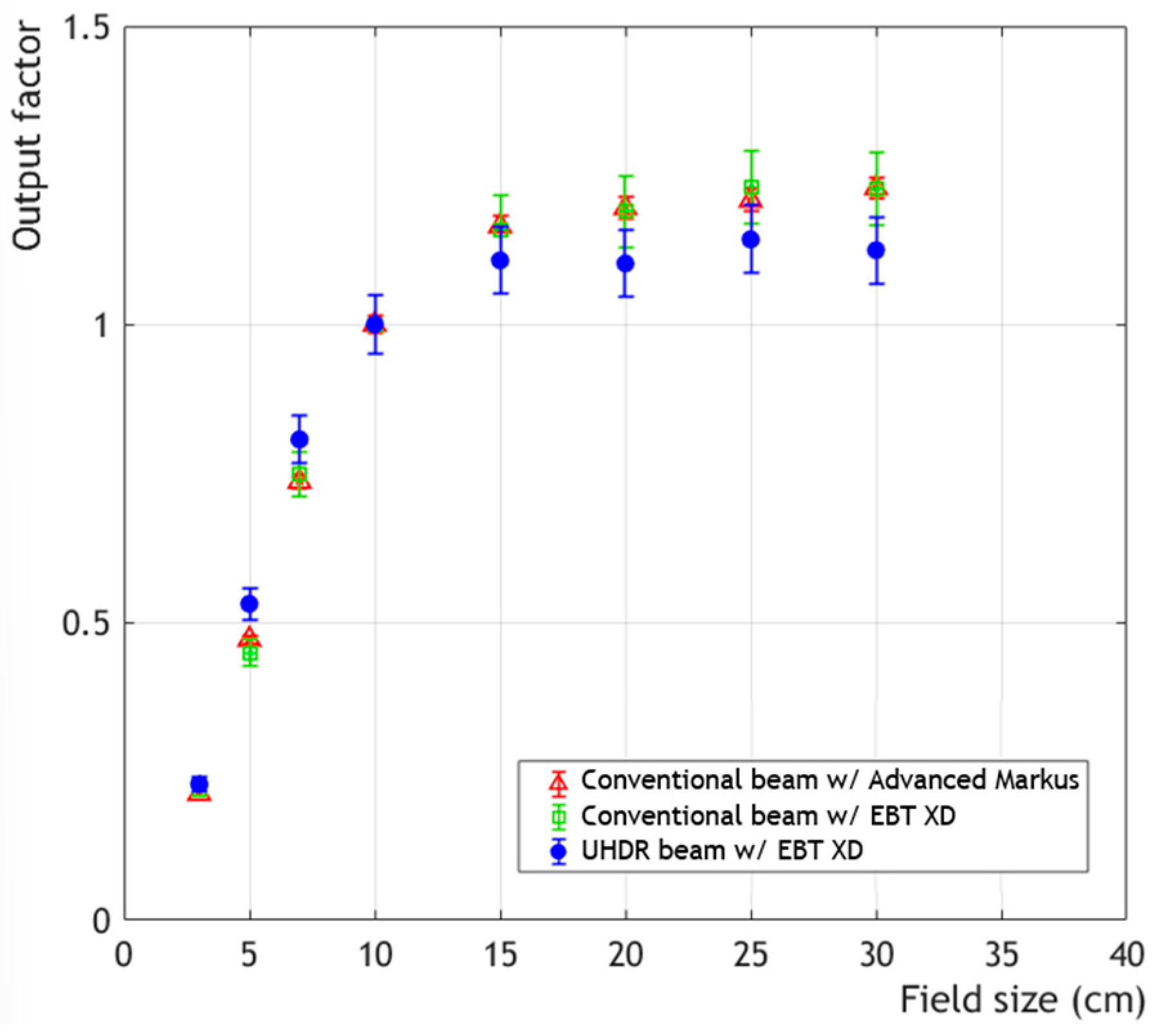
| Mode | Setup | R80 (cm) | R50 (cm) | Rp (cm) | zref (cm) |
|---|---|---|---|---|---|
| Conventional | Advanced Markus | 2.95 ± 0.10 | 3.61 ± 0.11 | 4.75 ± 0.18 | 2.07 ± 0.07 |
| EBT XD | 2.94 ± 0.07 | 3.65 ± 0.05 | 4.69 ± 0.26 | 2.09 ± 0.03 | |
| EBT XD with the applicator | 2.97 ± 0.05 | 3.67 ± 0.02 | 4.72 ± 0.24 | 2.10 ± 0.01 | |
| UHDR | EBT XD | 2.88 ± 0.10 | 3.54 ± 0.10 | 4.55 ± 0.28 | 2.03 ± 0.06 |
| EBT XD with the applicator | 2.89 ± 0.04 | 3.54 ± 0.02 | 4.55 ± 0.19 | 2.03 ± 0.01 |
| Dose Per Pulse (Gy) | Average Dose Rate (Gy/s) | Instantaneous Dose Rate (Gy/s) | |||||
|---|---|---|---|---|---|---|---|
| Mode | Conv | UHDR | Conv | UHDR | conv | UHDR | |
| Setting | Isocenter | (1.60 ± 0.08) × 10−4 | 0.63 ± 0.04 | (1.60 ± 0.08) × 10−2 | 83.6 ± 4.2 | (7.99 ± 0.40) × 101 | (3.60 ± 0.18) × 105 |
| Applicator | (2.52 ± 0.13) × 10−4 | 0.81 ± 0.04 | (2.52 ± 0.13) × 10−2 | 89.5 ± 4.5 | (1.26 ± 0.06) × 102 | (4.03 ± 0.20) × 105 | |
| Crosshair foil | (6.76 ± 0.34) × 10−4 | 2.22 ± 0.11 | (6.76 ± 0.34) × 10−2 | 309 ± 16 | (3.38 ± 0.17) × 102 | (12.3 ± 0.6) × 105 | |
| Wedge * | (0.92 ± 0.05) × 10−2 | 27.2 ± 1.4 | (92.3 ± 4.6) × 10−2 | n.d. ** | (4.61 ± 0.23) × 103 | (136 ± 7) × 105 | |
Disclaimer/Publisher’s Note: The statements, opinions and data contained in all publications are solely those of the individual author(s) and contributor(s) and not of MDPI and/or the editor(s). MDPI and/or the editor(s) disclaim responsibility for any injury to people or property resulting from any ideas, methods, instructions or products referred to in the content. |
© 2024 by the authors. Licensee MDPI, Basel, Switzerland. This article is an open access article distributed under the terms and conditions of the Creative Commons Attribution (CC BY) license (https://creativecommons.org/licenses/by/4.0/).
Share and Cite
Deut, U.; Camperi, A.; Cavicchi, C.; Cirio, R.; Data, E.M.; Durisi, E.A.; Ferrero, V.; Ferro, A.; Giordanengo, S.; Villarreal, O.M.; et al. Characterization of a Modified Clinical Linear Accelerator for Ultra-High Dose Rate Beam Delivery. Appl. Sci. 2024, 14, 7582. https://doi.org/10.3390/app14177582
Deut U, Camperi A, Cavicchi C, Cirio R, Data EM, Durisi EA, Ferrero V, Ferro A, Giordanengo S, Villarreal OM, et al. Characterization of a Modified Clinical Linear Accelerator for Ultra-High Dose Rate Beam Delivery. Applied Sciences. 2024; 14(17):7582. https://doi.org/10.3390/app14177582
Chicago/Turabian StyleDeut, Umberto, Aurora Camperi, Cristiano Cavicchi, Roberto Cirio, Emanuele Maria Data, Elisabetta Alessandra Durisi, Veronica Ferrero, Arianna Ferro, Simona Giordanengo, Oscar Martì Villarreal, and et al. 2024. "Characterization of a Modified Clinical Linear Accelerator for Ultra-High Dose Rate Beam Delivery" Applied Sciences 14, no. 17: 7582. https://doi.org/10.3390/app14177582
APA StyleDeut, U., Camperi, A., Cavicchi, C., Cirio, R., Data, E. M., Durisi, E. A., Ferrero, V., Ferro, A., Giordanengo, S., Villarreal, O. M., Mas Milian, F., Medina, E., Olivares, D. M. M., Mostardi, F., Monti, V., Sacchi, R., Salmeri, E., & Vignati, A. (2024). Characterization of a Modified Clinical Linear Accelerator for Ultra-High Dose Rate Beam Delivery. Applied Sciences, 14(17), 7582. https://doi.org/10.3390/app14177582






